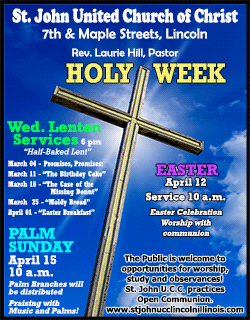Coronavirus weighs on strained American system to care for homeless
 Send a link to a friend
Send a link to a friend
 [March 12, 2020]
By Laila Kearney [March 12, 2020]
By Laila Kearney
NEW YORK (Reuters) - Dexter Johnson often
comes to the Bowery Mission to get a free meal, having struggled off and
on with homelessness, but the 33-year-old New Yorker is thinking twice
about sitting down in the crowded cafeteria and risking exposure to
novel coronavirus.
Johnson, one of an estimated 550,000 people to go homeless on any given
night in the United States, is worried crowds at the lunch service could
expose him to a virus that has no vaccine.
"This is the type of thing where you need to stay away from other
people," he said from the Bowery Mission dining room, where volunteers
have hung posters detailing ways to avoid catching or spreading the
virus. "That's hard to do."
As known cases of COVID-19 in the United States quickly multiply,
homeless people and their advocates are preparing for an outbreak in a
population more susceptible to illness and with no way to isolate or
recover at home.
Shelters and healthcare providers from Los Angeles to Boston are
attempting to erect quarantine zones and purchase protective gear to
stop the virus from spreading to the roughly 1% of Americans who are
homeless at some point in a given year.

But finding the space and the budget for even basic safeguards
recommended by the Centers for Disease Control and Prevention - washing
hands regularly and waiting out a potential illness in private - will be
a complex undertaking when it comes to the homeless, advocates and
health experts say.
"In a shelter system that is already bursting at the seams, the ability
to isolate and quarantine people and families is going to be very
difficult and very expensive," said Aine Duggan, president of homeless
advocacy group Partnership for the Homeless in New York.
SPREADS QUICKLY IN SHELTERS
New York City, Boston and Washington, D.C. have the highest rates of
men, women and children in shelters, while West Coast cities have the
largest overall number of homeless people, according to a White House
report from last September.
About 65% of homeless people, many of them children, sleep in shelters
and roughly 35% live on the streets.
"As we've seen with tuberculosis, norovirus, and so many others,
infections spread really quickly through the shelter system," said Dr.
Jessie Gaeta, chief medical officer of Boston Health Care for the
Homeless Program (BHCHP).
Homeless people also suffer disproportionately from chronic health
disorders, including heart and lung disease as well as diabetes, that
make them uniquely vulnerable to respiratory viral infections like
COVID-19, Gaeta said.
[to top of second column]
|

Cecil Barrow, 66, who said he was homeless living on the streets,
eats lunch inside The Bowery Mission in New York, U.S., March 10,
2020. Picture taken March 10, 2020. REUTERS/Shannon Stapleton

The homeless are more likely to contract illnesses in part because
of weakened immune systems due to additional stress, lacking
nutrition and sleep. Unsanitary living on the streets, where
restrooms are limited, pose additional risks.
Los Angeles' Union Rescue Mission, which has beds for about 1,200
men, women and children at its 24 shelters, has turned its gymnasium
into a quarantine zone for unsheltered people to go if they have a
fever or other symptoms linked to COVID-19.
"Somebody who gets this and is alone on the streets will really
suffer," said Union Rescue Mission Chief Executive Officer Andy
Bales.
The shelter has also stepped up cleaning efforts to nine times a day
and added hot-water hand washing stations outside of its buildings.
San Francisco officials this week said the city would set up
recreational vehicles and other temporary housing to isolate
homeless people with potential exposure to the virus.
FEWER VOLUNTEERS
While there is no indication the virus has reached homeless shelters
or encampments, it has already started to curtail the number of
volunteers at food banks and shelters in Texas, New York and
elsewhere.
Founded in 1879, the Bowery Mission on New York's Lower East Side
provides food, medical services and employment assistance to the
working poor and homeless men women and children.
Many volunteers for the Mission's meal services have canceled since
the shelter's corporate sponsors began telling employees to work
from home and avoid crowded areas, said James Winans, who heads the
370-bed shelter network, one of the oldest in the nation.
Cecil Barrow, who dines at the Bowery, said the new virus is just
another hardship homeless people like him regularly endure.

"The homeless are treated like we already have a virus, and most
people probably wouldn't care if we do," said Barrow, 66.
(Reporting by Laila Kearney; Additional reporting by Shannon
Stapleton and Hilary Russ; Editing by Lincoln Feast.)
[© 2020 Thomson Reuters. All rights
reserved.] Copyright 2020 Reuters. All rights reserved. This material may not be published,
broadcast, rewritten or redistributed.
Thompson Reuters is solely responsible for this content. |